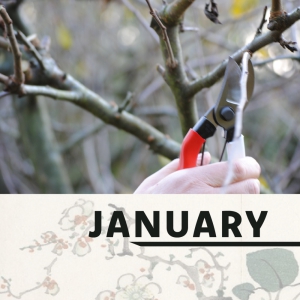
Even though it is still winter, nature never stands still! It is preparing for a new cycle full of growth and flowers. With a bit of luck, we can enjoy a nice white blanket of snow over the garden!
Garden
- Protect frost sensitive plants with an insulting layer. Leave a layer of snow or leaves around the stem or trunk, or use jute, straw, wood chips, or newspapers. Do not use plastic as the air can not permeate easily. Do not pack wet plants either as this encourages rot. As soon as it is a few days above freezing, you can let the plants “air out” for a bit. Do not forget container plants that need to overwinter in the barn. They will also need a little water and fresh air!
- Bring some color into the garden with frost resistant violets or winter heather
- Provide some tasty treats for the birds in the garden
- Turn the compost heap one more time so it is well broken down by Spring
- As long as it is not freezing, you can plant deciduous trees and shrubs. Tie the young stems or trunks to a pole for extra support during strong winds. After 2 years, the young plants have developed enough roots to stand firm.
- If you often suffer from lots of insects, wrap corrugated cardboard about 1 meter high around the trunk of a tree right before a freeze. The bugs will often crawl into this for added heat, then after a morning frost, remove the cardboard and burn it.
Pruning
- In January it is time to prune the fruit trees, if the temperature is staying reliably above freezing. Prune behind the bud if you want the tree to grow and keep the wound as small as possible. Always ensure that a bud remains so that the branch grows back nicely. As always, remove any dead or sick branches.
- Grapes can be pruned until about mid-January. After that, the sap will start again and you run the risk of the plant bleeding. This also applies to walnut, birch, chestnut, hornbeam, and maple. Protect wounds with a protective agent if necessary.
Lawn
- Try to walk on the lawn as little as possible to prevent soil compaction.
- A thin layer of snow on the lawn is insulating.



